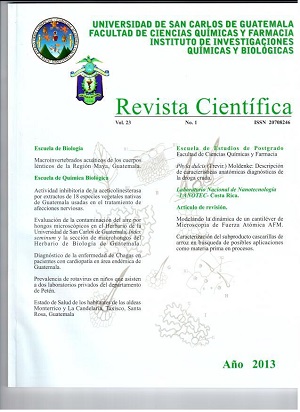Phyla dulcis (Trevir) Moldenke: diagnostic anatomical description of the crude drug.
Keywords:
Phyla dulcis (Trevir.) Moldenke, Verbenaceae, orozus, drugAbstract
Abstract
Phyla dulcis (Trevir.) Moldenke, commonly known as orozus, is a plant of the Verbenaceae family,widely distributed in Guatemala. Besides its sweetening property, orozus also possesses severalmedicinal properties (e.g. antibacterial, antispasmodic and anti-inflammatory properties). It is usedto treat respiratory diseases such as colds, coughs and bronchitis. This species has chemical variationsbetween different populations, which could suggest anatomy variation, including organoleptic,macroscopic and microscopic characteristics. Results of the anatomical comparison of 30 specimensof orozus from three different populations are presented, this in order to generate information thatcan help to validate popular uses of plants in the region, as well as to generate data for thephytopharmaceutical laboratories.Groups within and between populations were not evident in the cluster analysis performed in thisstudy. The drug consists of aromatic dried leaves with very sweet flavor. The leaf is amphystomatic,with majorly anomocytic stomata, but paracytic and diacitic stomata can also be found. This has onelayerepidermis and cells with striated cuticle. Larger and slightly wavy walls on the upper side ofthe leaf were found, and smaller highly sinuate on the underside of the leaf. The blade presentsabundant unicellular and multicellular trichomes, these can be simple or grounded in a rosette likecell disposition. In the underside of the leaf, the thricomes are glandular, capitated, uni or multicellulartype. The mesophyll usually has two layers of differentiated pallisade parenchyma and spongyparenchyma. The central vein has the same tissues as the rest of the leaf and also has a collateralvascular bundle type. Petiole presents a one-layer epidermis, followed by 2-4 layers of collenchyma,parenchyma and U-shaped vascular bundle.
Keywords:
Phyla dulcis (Trevir.) Moldenke, Verbenaceae, orozus, drug.
References
Referencias
Souto-Bachiller, FA, et al. (1997). Terpenoid Composition of Lippia dulcis.
Phytochemestry. Vol. 44 no.6: 1077-1086.
Cáceres, A. (1999). Plantas de Uso Medicinal en Guatemala. Eds. L.
Girón y A. Cáceres. Guatemala, GT, Editorial Universitaria. 402 p.
Cáceres, A Ed. (2006). Propuesta de Monografías Farmacopeicas de 10 Plantas Medicinales
Centroamericanas. OEA-AID
(Organización de Estados Americanos OEA; Agencia Interamericana de Cooperación para el Desarrollo AICD). Guatemala, GT. 88 p.
Compadre, C et al. (1985). Hernandulcin: An Intensely Sweet Compound Discovered by Review of Ancient Literature. Science. 227: 417-419.
Gattuso, M; Gattuso SJ. (1999). Manual de Procedimientos para el Análisis de Drogas en Polvo. AR. UNR Editora. s.p.
Granados, N. (2007). Establecimiento de los patrones de identidad farmacognóstica de Neurolaena lobata (L.) R. Br. ex Cass a partir de las características anatómicas de seis poblaciones silvestres. Tesis Lic. Guatemala, GT, USAC. Escuela de
Biología. 85 p.
Solís, PN et al. (2005). Manual de Caracterización y Análisis de Drogas Vegetales y Productos Fitoterápicos. OEA/AICD/AE 089/03: Proyecto
INSTITUTO DE INVESTIGACIONES QUÍMICAS Y BIOLÓGICAS
VOL. 23 No 1 REVISTA CIENTÍFICA
FACULTAD DE CIENCIAS QUÍMICAS Y FARMACIA
AÑO 2013
UNIVERSIDAD DE SAN CARLOS DE GUATEMALA
Desarrollo y Tecnología de Cultivo de Plantas Medicinales y Producción de Fitofármacos. 132p.
Williams, LO. (1981). The Useful Plants of Central America. Ceiba. 24: 3-342.

